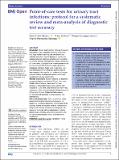Files in this item
Point-of-care tests for urinary tract infections : protocol for a systematic review and meta-analysis of diagnostic test accuracy
Item metadata
| dc.contributor.author | Fraile Navarro, David | |
| dc.contributor.author | Sullivan, Francis | |
| dc.contributor.author | Azcoaga-Lorenzo, Amaya | |
| dc.contributor.author | Hernandez Santiago, Virginia | |
| dc.date.accessioned | 2020-06-25T11:30:06Z | |
| dc.date.available | 2020-06-25T11:30:06Z | |
| dc.date.issued | 2020-06-03 | |
| dc.identifier | 268401282 | |
| dc.identifier | a4d080cf-5be0-4d18-8796-d8f6cb3f0d18 | |
| dc.identifier | 85086008724 | |
| dc.identifier | 000561433300009 | |
| dc.identifier.citation | Fraile Navarro , D , Sullivan , F , Azcoaga-Lorenzo , A & Hernandez Santiago , V 2020 , ' Point-of-care tests for urinary tract infections : protocol for a systematic review and meta-analysis of diagnostic test accuracy ' , BMJ Open , vol. 10 , no. 6 , e033424 . https://doi.org/10.1136/bmjopen-2019-033424 | en |
| dc.identifier.issn | 2044-6055 | |
| dc.identifier.other | ORCID: /0000-0002-8544-1483/work/75610493 | |
| dc.identifier.other | ORCID: /0000-0003-3307-878X/work/75610544 | |
| dc.identifier.other | ORCID: /0000-0002-1108-7071/work/75610548 | |
| dc.identifier.other | ORCID: /0000-0002-6623-4964/work/75610458 | |
| dc.identifier.uri | https://hdl.handle.net/10023/20146 | |
| dc.description | Funding: DFN is supported by an NES general practice academic fellowship, AAL is supported by an HDR UK clinical postdoctoral fellowship and VHS is supported by an NRS clinical academic fellowship. | en |
| dc.description.abstract | Introduction Urinary tract infections (UTIs) are the second most common type of infection worldwide, accounting for a large number of primary care consultations and antibiotic prescribing. Current diagnosis is based on an empirical approach, relying on symptoms and occasional use of urine dipsticks. The diagnostic reference standard is still urine culture, although it is not routinely recommended for uncomplicated UTIs in the community, due to time to diagnosis (48 hours). Faster point-of-care tests have been developed, but their diagnostic accuracy has not been compared. Our objective is to systematically review and meta-analyse the diagnostic accuracy of currently available point-of-care tests for UTIs. Methods and analysis Studies evaluating the diagnostic accuracy of point-of-care tests for UTIs will be included. PubMed, Web of Science, Embase and Cochrane Database of Systematic Reviews were searched from inception to 1 June 2019. Data extraction and risk-of-bias assessment will be assessed using the Quality Assessment of Diagnostic Accuracy Studies tool. Meta-analysis will be performed depending on data availability and heterogeneity. Ethics and dissemination This is a systematic review protocol and therefore formal ethical approval is not required, as no primary, identifiable, personal data will be collected. Patients or the public were not involved in the design of our research. However, the findings from this review will be shared with key stakeholders, including patient groups, clinicians and guideline developers, and will also be presented and national and international conferences. | |
| dc.format.extent | 4 | |
| dc.format.extent | 281625 | |
| dc.language.iso | eng | |
| dc.relation.ispartof | BMJ Open | en |
| dc.subject | RC Internal medicine | en |
| dc.subject | 3rd-DAS | en |
| dc.subject.lcc | RC | en |
| dc.title | Point-of-care tests for urinary tract infections : protocol for a systematic review and meta-analysis of diagnostic test accuracy | en |
| dc.type | Journal article | en |
| dc.contributor.institution | University of St Andrews. Population and Behavioural Science Division | en |
| dc.contributor.institution | University of St Andrews. School of Medicine | en |
| dc.contributor.institution | University of St Andrews. Sir James Mackenzie Institute for Early Diagnosis | en |
| dc.identifier.doi | https://doi.org/10.1136/bmjopen-2019-033424 | |
| dc.description.status | Peer reviewed | en |
This item appears in the following Collection(s)
Items in the St Andrews Research Repository are protected by copyright, with all rights reserved, unless otherwise indicated.

